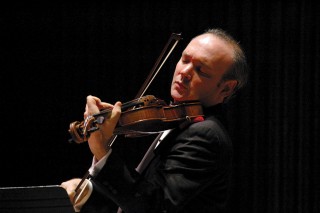Column Name
Title

Paul Neubauer
(Photo by Tristan Cook)After graduating from Juilliard, Paul Neubauer (BM '82, MM '83) became, at age 21, the youngest string principal ever to join the New York Philharmonic, where he spent six years before leaving in 1990 to pursue solo and chamber work. Along the way he joined the Juilliard faculty and the Chamber Music Society of Lincoln Center, in 1989. Appointed last spring as artistic director of the Mostly Music series in New Jersey, he'll make his Chicago Symphony debut in 2018.
Body
Why did you become a violist?
It truly was my destiny. My godfather was the Viennese-born violist Paul Doktor (faculty 1971–89), and he was a major influence in my musical and personal evolution from a very early age. I also studied with him during my teenage summers and at Juilliard. On top of this, my older siblings played the violin and cello, so viola was the perfect choice since this would complete a string trio. Unfortunately that string trio lasted about 10 minutes since my siblings were not as committed to a life in classical music.
And you're still part of a musical family …
Yes, my wife, Kerry McDermott, is a violinist with the New York Philharmonic, and our children, Oliver and Clara, both play the violin and attend the Juilliard Pre-College program. I have told my children countless times that the viola is a superior instrument to the violin, but they unfortunately have not taken my advice as of yet. On occasion, we enjoy playing four-violin quartets with three violins and a viola.
Did any particular recordings inspire you as a child?
My parents enjoyed hearing classical music whenever they were at home, so they always had recordings or the radio playing. I was very interested in viola recordings by Paul Doktor and William Primrose (faculty 1955–57), but also loved the recordings of Kreisler, Heifetz, Elman, Feuerman, Piatigorsky, and many other string players of that generation. I also listened to recordings by the Guarneri Quartet and the Quartetto Italiano among others. Later on I started listening to early jazz as well as salon and “gypsy” music recordings. And on occasion, I serenade the audience with a gypsy encore by strolling around the hall. I usually figure out a way to make a surprise entrance into the hall; sometimes I quietly enter through a door to the audience and start playing or I sit in the audience and jump up to start playing.
Do you have a funny performance story?
I was playing with an orchestra in a seaside town in New England and every couple of minutes a nearby foghorn would go off. For my encore, I improvised a duet with the foghorn, meaning that it would make its drone and I would try to time what I played to fill the empty spaces. I guess it worked fine since I got a review suggesting that I incorporate the foghorn in the piece the next time I played it.
Any upcoming recordings we should know about?
There's the Aaron Kernis Viola Concerto with the Royal Northern Sinfonia conducted by Rebecca Miller, which Signum Records will release this year. I premiered it with the St. Paul Chamber, Los Angeles Chamber, and Idyllwild Arts orchestras and the Chautauqua Symphony in 2014. There's also a recording I made with collaborative piano faculty member Margo Garrett of all the viola music of Ernest Bloch. The DAT tapes had been lost for years but recently resurfaced and are now being assembled for release.
If there was just one thing your students could take away from your lessons, what would it be?
To approach their instruments in the most relaxed way possible and to figure out how to achieve what they want with as little physical effort as possible. With this approach I feel it's easier to concentrate on the music.
What's your favorite way to unwind after a performance?
When I'm in New York, I like to go home and relax with my family. If I'm performing out of town with friends or colleagues, I like to celebrate the performance with a nice dinner and perhaps a glass of wine!




